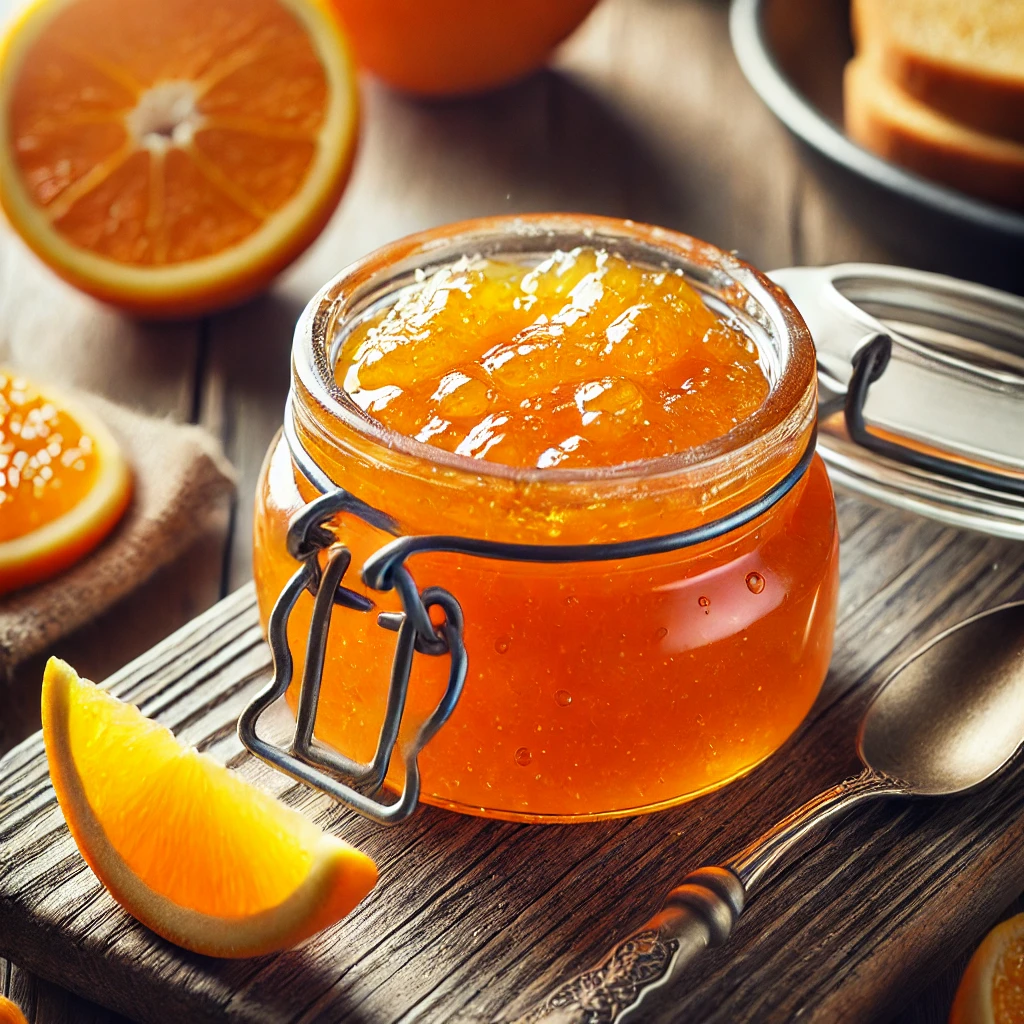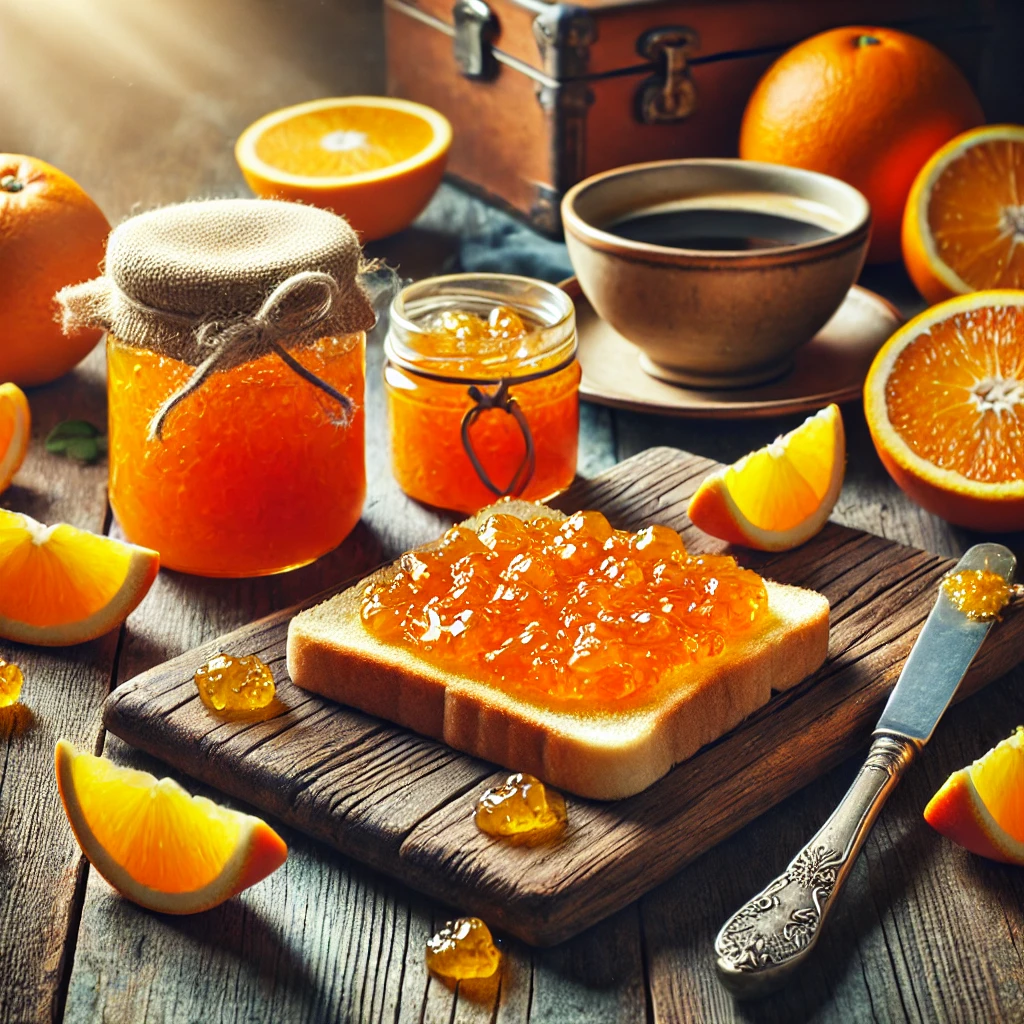If you’ve ever enjoyed a breakfast with toast topped with a sweet and tangy orange spread, you’ve likely encountered orange marmalade. This beloved condiment, known for its distinct citrus flavor and slightly bitter undertones, has been a breakfast staple for centuries. In this article, we’ll explore what orange marmalade is, how it differs from other spreads, its history, and tips for enjoying it to the fullest.
Table of Contents
ToggleWhat Is Orange Marmalade?
Orange marmalade is a type of fruit preserve made from oranges, sugar, and water. Unlike traditional jams, marmalade typically includes bits of orange peel, giving it a unique texture and a slightly bitter flavor. This combination of sweetness and tanginess makes it a perfect accompaniment for toast, scones, or biscuits during breakfast.

What Makes Marmalade Unique?
- Peel Inclusion: Marmalade often contains shredded or finely chopped citrus peel, which gives it a chewy texture.
- Bitterness: The orange peel contributes a subtle bitterness that balances the sweetness of the sugar.
- Citrus Base: While most jams focus on berries or stone fruits, marmalade is traditionally made with citrus fruits like oranges, lemons, or grapefruits.
A Brief History of Orange Marmalade
The origins of orange marmalade date back to 16th-century Scotland, where it was first created as a way to preserve citrus fruits. Early recipes used bitter Seville oranges, which are still the preferred variety for traditional marmalade today.
Key Historical Highlights:
- 16th Century: Marmalade was introduced as a method to preserve oranges for long journeys.
- 18th Century: It became a popular breakfast spread, especially in Britain.
- Modern Era: Today, marmalade is enjoyed worldwide, with numerous variations and creative twists.
How Orange Marmalade Differs from Other Spreads
While marmalade is a type of jam, it has distinct characteristics that set it apart:
| Feature | Orange Marmalade | Jam | Jelly |
|---|---|---|---|
| Main Ingredient | Citrus fruits (e.g., oranges) | Various fruits | Fruit juice |
| Texture | Contains peel and chunky bits | Smooth or slightly chunky | Smooth, no chunks |
| Flavor Profile | Sweet with a bitter undertone | Sweet, fruity | Sweet, pure fruit flavor |
| Common Uses | Toast, pastries, sauces | Toast, desserts | Spreads, glazes |
Popular Types of Orange Marmalade
There are many variations of orange marmalade, each with its own unique flavor and texture:
- Classic Seville Orange Marmalade:
- Made with bitter Seville oranges.
- Known for its traditional, robust flavor.
- Sweet Orange Marmalade:
- Uses sweet oranges for a milder taste.
- Great for those who prefer less bitterness.
- Chunky Orange Marmalade:
- Includes larger pieces of orange peel.
- Offers a more textured bite.
- Fine-Cut Marmalade:
- Features finely shredded peel for a smoother texture.
- Ideal for spreading on toast.
- Three-Citrus Marmalade:
- Combines oranges, lemons, and grapefruits.
- Delivers a complex and tangy flavor.
How to Enjoy Orange Marmalade
Orange marmalade is versatile and pairs beautifully with a variety of breakfast and snack options. Here are some ideas:
1. On Toast
- Spread a generous layer of orange marmalade on freshly toasted bread. Pair with butter for extra richness.
2. With Pastries
- Use as a topping for croissants, scones, or muffins for a citrusy kick.
3. As a Glaze
- Warm marmalade and use it as a glaze for roasted meats, such as ham or chicken.
4. In Desserts
- Incorporate marmalade into cakes, cookies, or tarts for a sweet and tangy flavor.
5. With Cheese
- Pair marmalade with soft cheeses like brie or cream cheese for a delightful contrast of flavors.
Health Benefits of Orange Marmalade
While orange marmalade is often considered a sweet indulgence, it does have some nutritional benefits when consumed in moderation:
- Rich in Vitamin C: Thanks to its citrus base, marmalade is a source of immune-boosting vitamin C.
- Low in Fat: Marmalade is typically fat-free, making it a light choice for breakfast spreads.
- Contains Antioxidants: The orange peel provides antioxidants, which may support overall health.
FAQs About Orange Marmalade
1. What is orange marmalade made of?
Orange marmalade is made from oranges (including the peel), sugar, and water.
2. Is orange marmalade the same as orange jam?
No. Marmalade specifically refers to citrus-based preserves that include peel and have a slightly bitter taste, whereas jam is smoother and sweeter.
3. Can I make orange marmalade at home?
Absolutely! Homemade marmalade typically involves simmering oranges, sugar, and water until the mixture thickens.
4. What’s the best bread for marmalade?
Marmalade pairs wonderfully with hearty breads like sourdough, multigrain, or brioche.
5. Can marmalade be used in savory dishes?
Yes, it’s often used as a glaze for meats or mixed into sauces for a tangy flavor.
6. What type of oranges are best for marmalade?
Bitter Seville oranges are traditional, but sweet oranges can also be used for a milder flavor.
7. How should orange marmalade be stored?
Store unopened jars in a cool, dark place. Once opened, refrigerate and consume within a few weeks.
8. Is marmalade healthy?
While marmalade contains sugar, it also offers vitamin C and antioxidants from the orange peel.
9. Why is marmalade bitter?
The bitterness comes from the orange peel, which is included in the preserve.
10. Can I freeze orange marmalade?
Yes, marmalade can be frozen in airtight containers for extended storage.
Conclusion
The orange jam spread you enjoy on your morning toast is called orange marmalade. This delightful preserve, with its sweet and slightly bitter flavor, has been a breakfast staple for centuries. Whether you prefer it classic, chunky, or fine-cut, orange marmalade is a versatile and flavorful addition to your pantry. Try it on toast, pastries, or even in savory dishes to explore its full range of possibilities!
More About Orange Marmalade: A Citrus Classic
If you’re intrigued by the wonders of orange marmalade, there’s even more to uncover about this delightful citrus spread. Let’s dive deeper into its history, creative uses, and the secrets that make it a favorite breakfast companion.
A Deeper Dive Into Marmalade’s History
Orange marmalade has a rich history tied to the preservation of citrus fruits. Its origins are often linked to Scotland, where it became popular in the 18th century, but the story begins much earlier.
1. Ancient Beginnings
- Citrus preserves date back to ancient civilizations. Early methods involved cooking fruit with honey to create sweet preserves.
- Marmalade as we know it evolved later with the addition of sugar, which became widely available in Europe during the Middle Ages.
2. The Role of Seville Oranges
- Seville oranges, known for their bitterness, became the preferred variety for marmalade in the 17th century. Their high pectin content helps marmalade set perfectly.
- These oranges were imported from Spain to Britain, where they became a prized ingredient.
3. Marmalade’s Rise in Britain
- By the 18th century, marmalade was a breakfast essential in Britain. It was particularly favored for its ability to preserve citrus fruits during winter months.
- Scottish producer Janet Keiller is credited with commercializing marmalade in 1797, turning it into a household product.
Creative Uses for Orange Marmalade
Orange marmalade isn’t just for toast! Its versatile flavor makes it a fantastic ingredient in a variety of dishes, both sweet and savory.

Sweet Creations
- Marmalade Tart: Use it as a filling for a buttery tart shell, topped with whipped cream.
- Marmalade Cookies: Mix marmalade into cookie dough for a citrusy twist.
- Layer Cakes: Spread marmalade between layers of vanilla or chocolate cake for added flavor and moisture.
Savory Applications
- Glazed Meats: Combine marmalade with soy sauce or mustard to glaze chicken, pork, or ham.
- Salad Dressing: Whisk marmalade with olive oil, vinegar, and Dijon mustard for a tangy dressing.
- Cheese Pairing: Serve marmalade alongside sharp cheddar, creamy brie, or goat cheese.
The Science Behind Marmalade’s Texture
Marmalade owes its unique texture and set consistency to a key ingredient: pectin. Pectin is a natural substance found in the peel and pith of citrus fruits. When combined with sugar and heated, pectin helps marmalade gel and thicken.
Why Marmalade Includes Peel
- The peel not only provides flavor but also contains a significant amount of pectin.
- By simmering the peel, marmalade develops its signature texture and subtle chewiness.
The Importance of Sugar
- Sugar isn’t just a sweetener—it’s a preservative that helps extend the shelf life of marmalade.
- It also interacts with pectin and acid (naturally present in oranges) to create the gel-like consistency.
Types of Orange Marmalade You Might Encounter
Orange marmalade comes in a variety of styles, each suited to different tastes and uses:
1. Dark Marmalade
- Cooked for longer, resulting in a richer, caramelized flavor and a darker color.
2. Whiskey Marmalade
- Infused with a splash of whiskey for added depth and warmth.
3. Spiced Marmalade
- Includes spices like cinnamon, clove, or ginger, perfect for the holidays.
4. Sugar-Free Marmalade
- Sweetened with natural alternatives, ideal for those looking to reduce sugar intake.
Making Homemade Orange Marmalade
Crafting your own orange marmalade at home is a rewarding process. Here’s a simple guide:
Ingredients:
- 6 Seville oranges (or sweet oranges if unavailable)
- 1 lemon
- 8 cups of water
- 6 cups of sugar
Steps:
- Prepare the Oranges:
- Wash the oranges and lemon thoroughly. Slice them thinly, removing seeds but keeping the peel.
- Simmer the Fruit:
- Combine the fruit slices and water in a large pot. Simmer for about an hour until the peel softens.
- Add Sugar:
- Stir in the sugar and bring to a boil. Cook until the mixture reaches 220°F (check with a candy thermometer).
- Test for Setting:
- Spoon a small amount onto a chilled plate. If it gels and wrinkles when pushed, it’s ready.
- Jar the Marmalade:
- Pour into sterilized jars, seal, and let cool before storing.
Tips for Choosing the Best Store-Bought Marmalade
If making your own marmalade isn’t an option, choosing the right store-bought variety can elevate your breakfast experience:
- Check the Label: Look for marmalade with a high percentage of fruit and natural ingredients.
- Consider the Cut: Fine-cut marmalade spreads more easily, while chunky marmalade provides a heartier texture.
- Flavor Variations: Experiment with varieties like blood orange, ginger-infused, or three-citrus marmalades.
FAQs About Orange Marmalade
1. Is marmalade always made with oranges?
No, while orange is the most common, marmalade can also be made with other citrus fruits like lemons, grapefruits, or limes.
2. Can marmalade be used in baking?
Yes, marmalade adds a citrusy flavor to cakes, cookies, and muffins.
3. How long does homemade marmalade last?
When stored in sterilized jars, it can last up to a year in a cool, dark place.
4. Why is Seville orange marmalade so popular?
Seville oranges have a high pectin content and a bitter flavor that balances the sweetness of sugar, making them ideal for marmalade.
5. Is marmalade vegan?
Yes, most marmalade is vegan, as it’s typically made from fruit, sugar, and water.
6. Can I mix other fruits with orange marmalade?
Absolutely! Marmalade pairs well with strawberries, cranberries, or even figs for unique flavors.
Conclusion
The orange jam spread on toast at breakfast is known as orange marmalade, a timeless classic that combines sweet, tangy, and slightly bitter flavors. Whether you enjoy it on toast, use it in baking, or incorporate it into savory dishes, orange marmalade is a versatile and delicious addition to your pantry. From its storied history to its wide range of uses, this citrus delight remains a favorite for breakfast lovers around the world.

